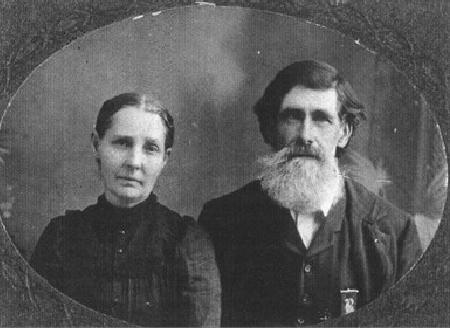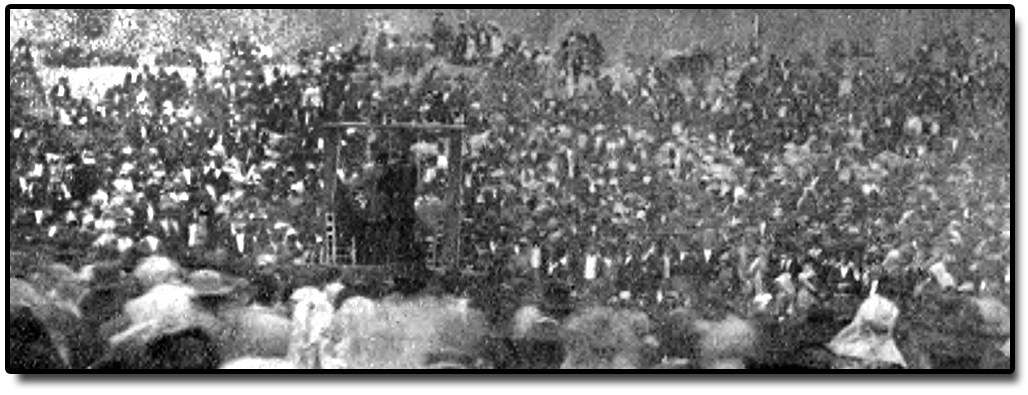FOUGHT FOR THE UNION ~ BURIED A CONFEDERATE
Isabelle Caroline Burgess & John Martin Lafayette Stone
Isabelle Caroline Burgess (My Second Cousin 3X Removed)
Isabelle was born in Bledsoe County, Tennessee, on August 8, 1852. She was the daughter of Nancy Grace Campbell and John Hiram 'King' Burgess. She married John Martin Lafayette Stone. He was born in Bledsoe County, Tennessee, on April 6, 1845. They were married on August 28, 1866, in Tennessee (she was 14 and he was 21) and had 10 children in 21 years. Isabelle died on January 6, 1914, in Bledsoe County, Tennessee, at the age of 61. Lafayette married a second time. He died on January 8, 1929, in Fordland, Missouri, at the age of 83.
Isabelle Caroline Burgess (1852 - 1914)
is your 2nd cousin 3x removed
mother of Isabelle Caroline Burgess
mother of Nancy Grace Campbell
father of Martha "Patsy" Toler Allison
son of John Allison JR
son of Joseph "Mine Lick Joe" Allison
son of William Herbert Allison
son of William Carter Allison
son of William Luther Allison
You are the daughter of Ernest Haywood Allison
While researching Isabelle, my ancestor, I happened
upon her husband's story. A story of great sadness.
Read on, my friends...
The Civil War officially began on April 12, 1861, and ended on May 10, 1865.
Lafayette served in the Civil War and enlisted around the age of 14.
He was a member of the 2nd TN Infantry Company D.
(I have attached an affidavit stating that he did not know his exact age when he enlisted.)

What makes Lafayette's Civil War interesting?
Lafayette was buried as a Confederate (notice the CSA on the Confederate stone) ~ but was a Union Soldier.
This mistake was corrected 75 years later.
I respectfully share part of his story below.
(I learned that Confederate stones were pointed on the top,
and Union Stones were rounded at the top.)
HERE IS LAFAYETTE'S STORY
(excerpt taken from a story written by a Great, Great Grand of Lafayette)
[Funny what you can find out when you start searching your roots. I had tried for years to find my Great Great Grandfather, Lafayette Stone's Civil War records. I had visited his grave site many times, took pictures the whole nine yards. My cousin, Steve Ince's wife, Janice had tried also, but we both ran out of luck.
While vacationing in Washington D.C. one time, I went to the Archives building to get some copies of civil war and Revolution war records. I took a picture of Lafayette's stone with me. I showed it to one of the gentlemen sitting there as you enter the Archives. He said" you won't find his records here, that is a confederate stone, you will have to obtain those records at the state level. I really didn't know until then that confederate stones came to a point on top of the stone, and Union stones were round…]
[We went to Jefferson City, Missouri, the capitol of Missouri. We went to the Archives there and searched microfilm's and books, and the lady who was helping us told us that she didn't know why the records weren't there, because it was evident by the shape of the stone and what it had on it that he was a confederate.
So, once again, I was let down, no records found. Then I sat down at the computer one day and started google and put in Lafayette Stone, with the troop # ect. I found him listed under the survivors of Andersonville Prison in Georgia…]
I started researching Andersonville Prison. The more I read about this place, the more it made me sick. This was by far the worst Prison for either side, during the civil war. The prison was overcrowded by 5-6 times it's intended capacity. The Confederate's mainly put the Union soldiers in the prison and forgot them. Most died, very few made it out alive, and most of those suffered bad health the rest of their lives. I was appalled.
Then I started thinking, how terrible it was that Lafayette Stone fought for and was true blue to the Union, thrown into a hell hole called Andersonville, survived and lived to tell about it, and was buried under a confederate gravestone. I do not and may never find out how that Confederate stone got placed there, who ordered it, ect. But, I knew I had to make it right…]
[I contacted the people who set stones in cemeteries and set a date to change the stone. I got to thinking that
We watched as the men removed the old confederate stone and set the new Union stone. It was very moving when the military team shot the guns and performed the flag folding ceremony, but when they played "Taps", that really moved me, and I felt good inside that I had made a wrong right. I knew Lafayette would never know about the mistake, but I know and that makes me feel good to have been a part of this…]
Lafayette and Isabelle Stone are buried in Cass Chapel Cemetery, between Fordland and Marshfield, Missouri.
I have found out a lot of interesting things with this genealogy hobby, but, this was one of the most interesting by far. I hope to some day find out who ordered the confederate stone and why. ~ Judy Bench}
What an amazing story. Way to go, Judy Bench!
CASS CHAPEL / Cemetery - Missouri
Burial Site for Lafayette and Isabelle
Affadavit of Lafayette's Date of Birth
ANDERSONVILLE PRISON
Andersonville Civil War Prison, located in the village of Andersonville, Sumpter County, Georgia, became notorious for its overcrowding, starvation, disease, and cruelty. It was in operation from February 1864 to April 1865.
Andersonville Prison was established as a "stockade for Union enlisted men". The prison consisted of 27 acres and was enclosed with walls made of pine logs, which stood 15-20 feet high. The "stockade" held a hospital but no barracks were ever constructed for the prisoners. Originally intended to hold 10,000 men, Andersonville at one time held over 33,000 men. According to records, a total of 49,485 prisoners went through the gates of Andersonville Prison.
Prisoners suffered from hunger, disease, medical shortages, and exposure. The death rate at Andersonville was the highest of all Civil War prisons. A staggering 13,700 men died within thirteen months!
The superintendent of the prison was Captain Henry Wirz. It is said he was heartless and high-handed. John L. Ransom, a Michigan sergeant and Andersonville prisoner, wrote in his diary on May 10, 1864: "Captain Wirz very domineering and abusive, is afraid to come into camp any more. A thousand men here would willingly die if they could kill him first. The worst man I ever saw." Captain Wirz was tried and hanged by a military court after the war. (Just before he was executed by hanging in Washington, D.C., on November 10, 1865, Wirz reportedly said to the officer in charge, "I know what orders are, Major. I am being hanged for obeying them." The 41-year-old was one of the few people convicted and executed for crimes committed during the Civil War.)
Andersonville Prison was investigated by the Confederate War Department and they recommended that the majority of the prisoners be transferred to Florence, SC and Millen, GA. This mere fact would attest to the horrors suffered by prisoners at Andersonville.
The prisoner's burial ground is now a National Cemetery and contains 13,737 graves, of which 1,040 are marked unknown. The area is now designated as a National Park and can be visited. Visitors will experience a great sense of sorrow upon seeing this vast number of graves.
There are many photos available ~ sad, deplorable...
Judy Bench wrote of Lafayette's Experience in Andersonville Prison
"First let me tell you what I have read and seen in a movie about Andersonville Prison. There were guards posted every so many feet apart all around the walls of Andersonville. These guards were in towers attached to the walls. Inside the walls there was a line drawn a few feet from the wall called the dead line, because anyone who dared to cross that line was shot - no questions asked. Robert Stone, a grandson of Gilbert Stone (that family line is :Lafayette>Thomas>Gilbert>Robert>Robert) told of a story he remembers his grandfather, Gilbert telling. Gilbert said that Lafayette was so weak while in Andersonville,he couldn't walk very well and came so close to the dead line and he fell over the dead line. The guards raised their guns and aimed, but for some reason didn't shoot him."
ANDERSONVILLE: DEPLORABLE CONDITIONS
The stockade at Andersonville was hastily constructed using slave labor, and was located in the Georgia woods near a railroad but safely away from the front lines. Enclosing some 16 acres of land, the prison was supposed to include wooden barracks but the inflated price of lumber delayed construction, and the Yankee soldiers imprisoned there lived under open skies, protected only by makeshift shanties called shebangs, constructed from scraps of wood and blankets. A creek flowed through the compound and provided water for the Union soldiers; however, this became a cesspool of disease and human waste.
Some days, more than 100 prisoners died.
This mass grave at Andersonville vividly illustrates the reality of Civil War prisons.
The Cuban bloodhound (attack dogs) was used to guard the prison at Andersonville.
This dog's name was Spot. He stook three feet at the shoulder and weighed 159 points.
With that size and aggressive disposition, he must have been quite a dangerous animal.
This breed is extinct…and that's a good thing!
Death Certificate of Lafayette Stone
















Comments
Post a Comment